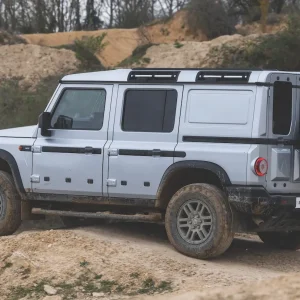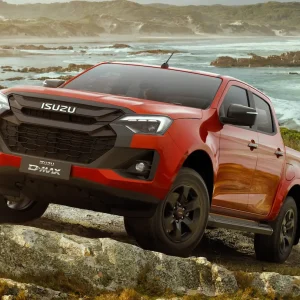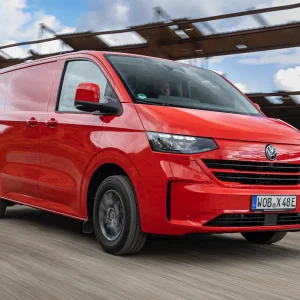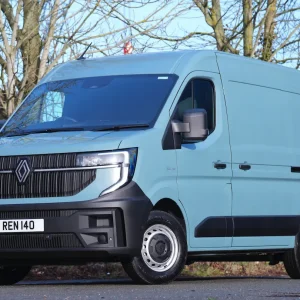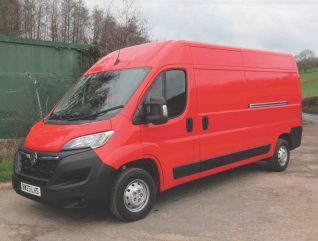
Stellantis plans to introduce revamped and revitalised versions of all the models in its light commercial line-up during the course of this year. The impact of the changes could be substantial given that the global automotive behemoth owns the Citroen, Peugeot, Vauxhall and Fiat Professional brands among others.
In the meantime its existing offerings remain available, including Vauxhall’s Ford Transit-rivalling Movano. Although there are some differences between them, Movano, Citroen’s Relay, Peugeot’s Boxer and Fiat Professional’s Ducato all share the same basic design.
So does Toyota’s new Proace Max thanks to a long-standing joint venture between Stellantis and the Japanese manufacturer.
Grossing at from 3.0 to 4.0 tonnes, the front-wheel-drive Movano is up for grabs as a van, a chassis cab, a crew cab and as a platform cab. In van guise it comes with four different lengths and three different heights, with load cubes ranging from 8.0m3 to an echoing 17.0m3.
However, only one specification level is listed; Prime.
Prospective Movano customers are faced with a 2.2-litre diesel at 120hp, 140hp or 165hp married to a six-speed manual gearbox. If you wish to go zero-emission then you can opt for an electric powertrain with a 90kW motor and a 75kWh battery pack.
It is worth noting that Vauxhall lists a number of special conversions in its price and specification guide, including tippers, dropsides, Lutons, and low-floor Lutons.
We opted for a 165hp L3H2 3.5-tonne van however with a 13.0m3 cargo area, an overall length of 5,998mm, an overall height of 2,522mm, an overall width of 2,690mm – including the exterior mirrors – and a 4,035mm wheelbase. Here’s how we fared.
Load bay
Access to the cargo area is by means of a sliding door on each side (the offside one is optional) and through twin rear doors which can be swung through 90º, and through 180º if you unhook the easy-to-release stays.
Good to see that the doors have big exterior handles which you can grasp without having to take off your insulated gloves. Front-wheel-drive makes it easy to step in and out of the cargo box, which features two interior lights, and the generous dimensions of the side door apertures can only be applauded.
A full-height steel bulkhead separates the cab from the cargo area and there is no excuse for failing to secure your load properly. There are eight tie-down rings in the floor, two at the bottom of the bulkhead, and two in each of the sidewalls; an impressive 14 in total.
Looking for somewhere to stow your lashing straps? Then how about the shelf above the cab, accessible solely from the load bay?
Our vehicle’s load area was fully timbered out to protect it from damage.
Interior and equipment
With a dated-looking dashboard with a small colour touchscreen, the three-seater cab’s interior has an old-fashioned feel to it. However that is not to say that it is short of equipment or storage space.
The screen plays host to the DAB radio as well as to the satellite navigation system as part of a standard package under the Multimedia Navi Pro Banner. Customers benefit from a three-year subscription to Tom Tom Live which includes online navigation services.
Bluetooth connectivity and the ability to interface with Apple CarPlay and Android Auto are included in the deal. So is Vauxhall Connect, which gives you instant access to emergency support if you have an accident.
Air-conditioning forms part of the offer (our van was kitted out with an optional automatic system) and chills whatever you pop into the glovebox as well as keeping the cab interior cool. That should ensure your slab of milk chocolate doesn’t melt on a hot day.
A 12v power socket (there’s another one in the load area) and a USB port are present and correct, and electric windows are fitted along with heated and electrically-adjustable exterior rear-view mirrors with a separate lower wide-angle section.
Turning to storage space, aside from the, rather small, glovebox, which has a deep shelf above it, there are shelves above the windscreen on both the driver and passenger side. A lidded compartment sits on top of the dashboard next to four trays of varying sizes while each door features two bins, the lower one of which boasts a moulding which can accommodate a large bottle of water.
A moulding with a couple of cup-holders and two trays projects from the bottom of the dashboard. You’ll find another cup-holder to the left of the heating and ventilation controls on the fascia; good to see that you are not expected to fiddle about with the touchscreen every time you want to turn the heating up.
Pull down the centre section of the middle seat’s back and it turns into a small desk with a pair of cup-holders of different sizes and a clip to keep your paperwork tidy; assuming you still use paperwork.
Complete with an armrest and lumbar adjustment, the driver’s seat is height-adjustable. So is the steering wheel, which plays host to remote controls for the radio and phone.
Unusually for a van, the seat is suspended. You dial in your weight for the best level of comfort.
It is a pity, however, that the driving position is offset – this means that the driver doesn’t sit squarely behind the wheel, in other words, which makes it rather awkward. The buttons for the cruise control system, which includes a speed limiter, are on a steering column stalk.
As well as reversing sensors, the onboard safety systems include ABS, Electronic Brakeforce Distribution, Electronic Stability Programme with traction control and Hill Start Assist.
The traction control system can be switched off.
Our demonstrator’s safety was enhanced by the presence of an optional Drive Assist pack. It encompasses Automatic Emergency City Braking, Lane Keep Assist (which can be cancelled), High Beam Assist, and Traffic Sign Recognition. The last-named function features a display on the instrument panel which told us the speed limits on the roads we were travelling down.
Disc brakes – ventilated at the front – grace all four wheels.
Rear parking sensors are installed with a warning beep-beep-beep sounding whenever the van is reversing.
The lights come on automatically at dusk, the windscreen wipers are triggered when raindrops spatter the windscreen and a driver’s airbag is fitted. Our demonstrator also featured an optional passenger airbag.
The independent front suspension is pseudo-MacPherson with a lower wishbone and helical springs while the rear suspension features longitudinal single-leaf springs. A rigid axle helps support the back of the vehicle.
Anti-roll bars are to be found front and rear and double-acting hydraulic shock-absorbers are installed all round. Hydraulic power-assisted rack-and-pinion steering delivers a 14.2m kerb-to-kerb turning circle expanding to 14.4m wall-to-wall.
Our Movano sat on 15in steel wheels shod with Bridgestone Duravis R660 215/70 R15 tyres.
Remember that the handbrake lever is positioned between the driver’s seat and door. Make sure you release it fully and don’t get your clothing tangled up with it when you climb out.
Powertrain
Movano’s four-cylinder, 16-valve, double overhead camshaft, turbocharged, direct-injection diesel delivers maximum power at 3,750rpm. Top torque of 370Nm bites at 1,750rpm.
AdBlue is required to enable the van to comply with Euro 6D exhaust emission requirements and is held in a 19.0-litre reservoir.
Driving
With 165hp on tap, the most-powerful Movano does not lack performance, but a less-then-smooth gearchange inhibits your ability to make full use of it. That is especially the case when you are accelerating away from rest and up through the gears.
Engine noise is excessive, and while the ride isn’t too bad, it cannot be classed as outstanding. The suspended driver’s seat helps cushion its occupant from the worst of the buffeting.
The van is manoeuvrable at low speeds, despite its bulk, but caution is advised if you are proposing to corner at high speeds when out on the open road and unladen. Back off and take it steady, or you might come unstuck.
Put some weight in the back however and the handling improves significantly. Once we’d distributed 500kg of bagged sand across the cargo bed we were able to corner with far more confidence, with the van feeling more firmly anchored to the road surface and less inclined to veer off course.
Operating
A three-year/100,000-mile warranty is provided with no mileage limit during the first 12 months. Roadside assistance is included for the first year, and a five-year body panel anti-perforation warranty completes the deal.
Service intervals are set at two years/30,000 miles.
Vauxhall quotes official WLTP (Worldwide Harmonised Light Vehicle Test Procedure) Combined Low and Combined High fuel economy figures of 25.4mpg and 40.4mpg respectively.
The CO2 figures quoted respectively are 295g/km and 188g/km, with Stop/Start standard to help keep diesel consumption and CO2 emissions down. It can be switched off if necessary.
We averaged 32.4mpg according to the van’s onboard computer on part-laden runs which included (mostly rural) A- and B-roads, dual carriageways and busy market towns. Our Movano came with a spare wheel; a £200 option, which seems a little harsh. The body’s sides were protected from minor damage by deep rubbing strips.
Vauxhall Movano Prime 2.2D 165 M6 L3H2 3500
Price (ex VAT) £32,880
Price range (ex VAT) £26,895-£63,635
Gross payload 1,415kg
Load length 705mm
Load width (min/max) 1422mm/1870mm
Load bay height 1932mm
Load volume 13.0m3
Loading height 557mm
Rear door aperture 1562mm x 1790mm
Side door aperture 1250mm x 1755mm
Gross vehicle weight 3,500kg
Braked trailer towing weight 2,500kg
Engine size/power 2,179cc/165hp @ 3750rpm
Torque 370Nm @ 1,750rpm
Gearbox 6sp
Fuel economy(combined high WLTP) 40.4mpg
Fuel tank 90 litres
CO2 (combined high WLTP) 188g/km
Warranty 3yrs/100,000 miles
Service intervals 2yrs/30,000 miles
Insurance group 48E
Price as tested £36,950
Options
Traffic Red paint £650
Drive Assist pack £750
Fog lights with LED daytime running lights £400
Exterior mirrors with blind spot detection £150
Automatic air-conditioning £350
Suspended driver’s seat £370
Spare wheel £200
Passenger airbag £300
Offside sliding load area door £400
Load area timber floor cover and side panels £500
Rivals
Ford Transit
Price range (ex VAT) £37,935-£57,235
Load volume 9.5-15.1m3
Gross payload 895-2,209kg
Engines 105hp, 130hp, 155hp, 165hp, 170hp, 185hp 2.0 diesel, 135kW, 198kW electric motor
Verdict: Getting an upgrade for 2024 with a revamped infotainment system and a new eight-speed automatic transmission for front-wheel-drive variants, Transit ticks virtually all the boxes. Second-hand values are healthy, and dealers are ubiquitous, E-Transit is the model to watch as the industry goes zero-emission, with a claimed range of almost 200 miles.
Mercedes-Benz Sprinter
Price range (ex VAT) £32,465-£64,605
Load volume 7.8-17.0m3
Gross payload 731-2,813kg
Engines 150hp, 170hp, 190hp 2.0 diesel, 100kW, 150kW electric motor
Verdict: The latest electric Sprinter is way more appealing than its disappointing short-range predecessor, with a claimed range of nearly 250 miles. Battery- or diesel-powered, Sprinters boast plenty of safety features plus a high degree of connectivity, and rock-solid build quality should enable the Mercedes-Benz large van to withstand arduous duty cycles.
Volkswagen Crafter
Price range (ex VAT) £39,480-£54,790
Load volume 9.3-18.4m3
Gross payload 904-2,396kg
Engines 102hp, 140hp, 163hp, 177hp 2.0 diesel
Verdict: A new infotainment system and more driver-assistance features will characterise the updated Crafter scheduled for this year. Remember that Crafter is also marketed by MAN as the TGE, and that a battery-powered TGE is available with a 100kW electric motor. Crafter has many of Sprinter’s virtues, yet always seems to be in its shadow.
The Final Verdict
Design 6/10 – Lots of positives, but feels dated now
Cabin 6/10 – Well-equipped, with plenty of storage space, but the touchscreen is too small
Ride 7/10 – Optional suspended driver’s seat means you don’t feel the bumps so much
Refinement 6/10 – No squeaking or rattling, but noise insulation is inadequate
Load area 9/10 – Well-designed, with big side doors, and Good payload capacity
Handling/performance 7/10 – No issues with the latter, but over-enthusiastic cornering is not to be encouraged
Engine/transmission 6/10 – Former packs plenty of punch but is let down by the quality of the gear-change
Standard equipment 7/10 – Decent kit, including A/C and sat nav, but could use more onboard safety systems
Operating costs 7/10 – Sensible warranty and service intervals should keep running expenditure down
What Van? subjective rating 7/10 – Still a contender, but rather old-fashioned now. Its successor is way overdue
Overall Rating = 68/100

